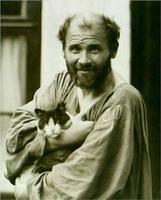Biography
Klimt was born in Baumgarten, a town near Vienna in Austria-Hungary in 1862. He was the second of seven children; his father was a gold engraver. Both of his brothers, Ernst Klimt and Georg Klimt, were also painters. While Gustav Klimt attended the University of Applied Arts Vienna from 1976 until 1883 he lived in poverty. He started his professional career after leaving the University of Applied Arts in 1883 and painted mostly murals and ceilings. In 1888, he received the “Golden Order of Merit” from Emperor Franz Josef I. In 1892 his father Ernst, and his brother Ernst, died, and Klimt became fiscally responsible for his family. Around this time Klimt’s art changed and he began painting a figure called Nuda Veritas or naked truth in many of his paintings which many think could have been because of the death of his father and brother, and might have also been a political statement against Austrian Society at the time. He met his lifelong partner, Emilie Lousie Floge, around 1890. Floge was an Austrian fashion designer whom Klimt made many designs for, the two of them using each other as inspiration frequently. Klimt never married, and was known to be promiscuous and some-what of a lady’s man, but many believe Floge to be what he would have considered a partner because of their hundreds of letters to each other. He is known to have at least 14 children, and is suspected to have quite a lot more.
Klimt was a founding member of the Vienna Secession founded in 1897, and was their first president. He painted for them until 1908. He entered his “Gold Phase” in 1907 with Portrait of Adele Bloch-Bauer with whom he is said to have had many affairs and possibly fathered a child. His famous painting The Kiss was also done in this period. Although this period was called his “Gold Phase” he had already been using gold leaf in many of his earlier paintings, the use of gold was never limited to this phase.
The Vienna Secession was created in 1897 by a group of artists who resigned from the Association of Austrian Artists. These artists were against the Associations conservatism and incline towards history painting. Many of the Secession artists were avant-guard and art nouveau but it was never limited towards one style. Many of their exhibitions had a theme that moved against nationalism in art and as a result they had many contacts with artists in other countries, mostly in France. The secessions most famous exhibition was in 1902 and was dedicated to Beethoven, in which Gustav Klimt made a frieze made to surround a sculpture made by another artist.
Klimt’s life as an artist lavish, although he was thought to be some-what of a hermit. His art was very successful both as a muralist and a portraitist. His paintings continue to be famous, like his portrait of Bloch-Bauer, otherwise known as Woman and Gold, which inspired a movie of the same title in 2015. The movie was about how this famous painting was stolen by Nazis and eventually returned to Bloch-Bauer’s decedents after a court case. Klimt’s studio was inside of his home and he would apparently walk around wearing only sandals and a long robe with nothing underneath. He never painted a self-portrait, when asked he said:
"I have never painted a self-portrait. I am less interested in myself as a subject for a painting than I am in other people, above all women... There is nothing special about me. I am a painter who paints day after day from morning to night ... Who ever wants to know something about me ... ought to look carefully at my pictures."
Here Klimt is admitting to his obsession with women, very rarely in his paintings do we see depictions of men and if we do they are catalysts for the women. For example, in his painting The Kiss (1907) the man is only there to kiss the woman, we do not even see his face. His body is covered in his golden costume and all we see of him is his neck, where the woman is holding onto him, and his hands, which cup the woman’s face.
